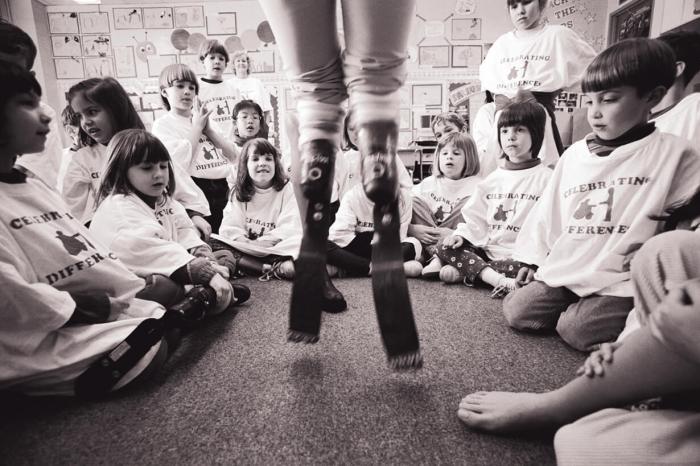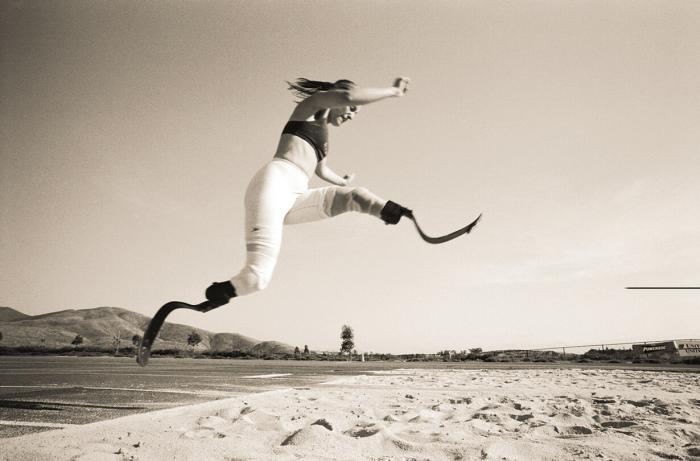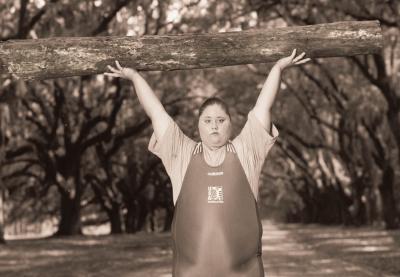A seemingly simple black-and-white photo helped change the way 10-year-old Dennis Maclaine judges people.
"Before, I just saw a big kid — not really an athlete," Maclaine said. "Now I think they could be an athlete and actually win a medal."
The photo, showing a teenager holding a log over her head, is part of "Game Face: Life Lessons Across the Curriculum," a teaching kit that challenges assumptions and builds confidence.
On the back of the card, the young woman is identified as weightlifter Cheryl Haworth, an Olympic bronze medalist. "If you saw Haworth in street clothes," the card asks, "would you think she was an athlete?" And, "Is there a difference between the way you expect a female athlete to look and a male athlete to look?"
"It gets you to think you shouldn't judge a book by its cover," said Adam Karas, 10, another student.
Game Face uses layered and powerful images of women and girls participating in sports to teach the complex curricula of body image, diversity, determination, tolerance and character. Questions associated with each image serve as prompts for discussion, writing assignments and other classroom activities.
"It's a wonderful way to touch on some of the social issues we don't get to focus on," said Alicia Montross, a 5th-grade teacher at F.L. Olmsted School in Easton, Mass., where Maclaine and Karas attend.
Consider another Game Face image:
The photo shows a smiling athlete with steel legs being interviewed on a running track. She is Aimee Mullins, a double-amputee and Paralympic record-holder.
On the back, Mullins is quoted as saying, "The functioning human body is beautiful." A question for students follows: "What do you think she meant by that?"
Ten-year-old Tamika Kersey had a ready answer.
"It shows me I can do whatever I want to even though I'm missing a part of my body," Kersey said. "I think that she's happy, and I think that's good."
Kersey has her own game face: She's the only girl on her football team. "If I like football, I think I can play," she said.

'Challenging Assumptions'
The educational kit is derived from a book and art exhibition, "Game Face: What Does a Female Athlete Look Like?" And everything came from one woman's vision.
While working as a sports writer for the San Francisco Chronicle, Jane Gottesman resented how little notice women's sports received from the media; she wanted to celebrate the profound effects sports can have on girls. Gottesman credits athletics with boosting her confidence, focus, teamwork and risk-taking skills.
Although the book and art exhibition came first, Gottesman's goal always was to bring these ideas into the classroom. "It's about challenging assumptions and taking lessons you learned in sports and using them in life," she said. "The photographs are so layered (that) they're successful at conveying sensitive material."
Geoffrey Biddle, co-curator of Game Face, said they pored through more than 200,000 photographs in creating the book and exhibition. Then they found a corporate sponsor.
Florence Emerson, senior vice president of MassMutual Financial Group, said the Game Face kit was an easy sell: "I looked at it and said, 'What would it take for us to be your sole sponsor?'"
The Game Face team and MassMutual targeted the program at middle schools because of peer pressure and self-esteem issues as well as the many emotional and physical changes children undergo from the ages of 10 to 14.

'A Team Builder'
MassMutual estimates Game Face kits are in 3,000 schools, youth centers and religious organizations nationwide. Although the kit was developed for middle school students, it also is being used by elementary, high school and special education students.
"We use it primarily as a team builder — as a way to enhance our abilities to work together in math (and) social studies," as well as other subjects, said Michelle Sevigny, who teaches a 5th-grade inclusion class at Annie Fisher Elementary School in Hartford, Conn. Sevigny and co-teacher Sarah McCarthy relied on Game Face primarily in the first two weeks of school to teach tolerance and convey expectations of acceptance and cooperation.
"Game Face deals with race issues, friendship issues, age, weight — it runs the gamut with tolerance," McCarthy said.
Ilisa D. Sulner is the principal at P721X, a special education high school in the Bronx. She said Game Face is especially effective with her students. "They see people with challenges trying to do things that they didn't think could be done," Sulner said. It also is a reading aid. "It's hard to find a program for adult students who have literacy problems that isn't insulting. This is a dignified approach to learning to read."
Teachers also say they love how Game Face inspires children.
Molly Solov, 11, related to one image that depicted a little girl with a Hula-Hoop.
"Even though it was big, she was determined to do it," Solov said. "It doesn't matter if you're short or tall or what type of person you are: If you put your heart to it, you can do whatever you want."
Or the picture of Aimee Mullins again, the double-amputee with legs of steel. Students learn, from the kit, that Mullins grew up on wooden legs and eventually helped design the steel model based on the legs of a cheetah.
"It tells you that you can be what you want to be," said Sedonia Dyer, 10. "Even though you have metal feet, you still can run."
